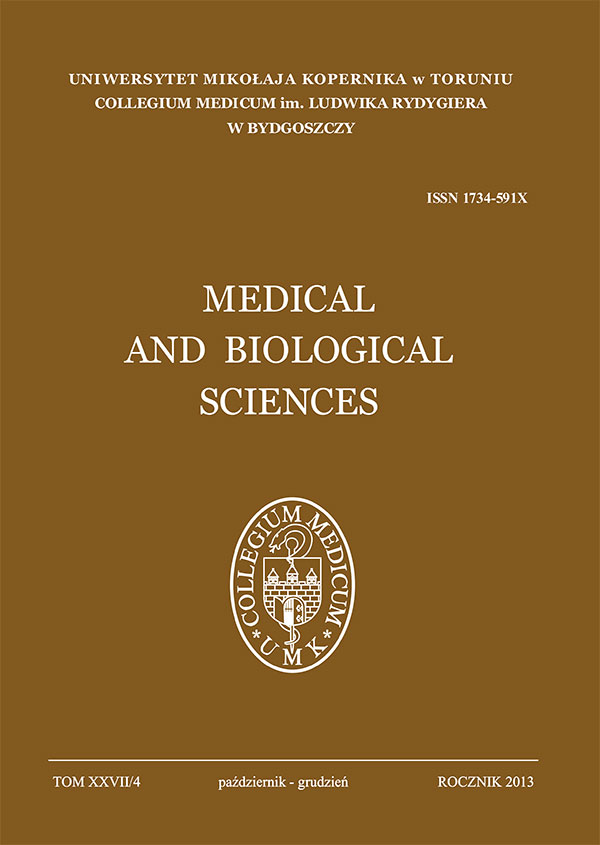Zespół Metaboliczny- problem epidemiologiczny?
DOI:
https://doi.org/10.12775/mbs-2013-0028Słowa kluczowe
zespół metaboliczny, insulinooporność, otyłość brzusznaAbstrakt
Głównymi elementami zespołu metabolicznego są otyłość brzuszna, nadciśnienie tętnicze, zaburzenia lipidowe pod postacią dyslipidemii aterogennej oraz zaburzenia gospodarki węglowodanowej pod postacią nieprawidłowej glikemii na czczo oraz cukrzycy typu 2. Pierwsza definicja zespołu metabolicznego została sformułowana przez Reavena w 1988 roku i nazwana zespołem X.
W Stanach Zjednoczonych zespół metaboliczny występuje u około 25% dorosłych obywateli. W Polsce, na podstawie danych z badania NATPOL PLUS, zgodnie z przyjętymi kryteriami NCEP-ATP III, zespół metaboliczny został rozpoznany u 20,3% osób dorosłych, natomiast zgodnie z kryteriami IDF u 26,3% badanych. Wszystkie składowe zespołu metabolicznego, takie jak otyłość brzuszna, hiperglikemia, nadciśnienie tętnicze oraz zaburzenia lipidowe (dyslipidemia aterogenna) stają się coraz częstsze u osób starszych i prowadzą do wzrostu jego występowania w ogólnej populacji.
Obecność zespołu metabolicznego wiążę się z około 3-4- krotnym wzrostem ryzyka sercowo-naczyniowego i ma wyodrębnić chorych zagrożonych epizodami sercowonaczyniowymi w możliwie jak najwcześniejszym stadium klinicznym. Jest on rozpoznawany coraz częściej i związany jest głównie ze zwiększeniem liczby osób z otyłością brzuszną i narastającą insulinoopornością. Jest to światowy problem epidemiologiczny, z którym trzeba walczyć w sposób intensywny.
Jest wskazaniem do wdrożenia odpowiedniej diety oraz zalecenia odpowiedniego wysiłku fizycznego w celu pierwotnej profilaktyki. Oczywiście, jeżeli jest to konieczne, dodatkowo należy wdrożyć leczenie farmakologiczne.
Bibliografia
De Nunzio C, Aronson W, Freedland SJ et al. The correlation between metabolic syndrome and prostatic disease. Eur Urol. 2011; 15.
Reaven GM: Banting lecture 1988. Role of insulin resistance in human disease. Diabetes. 1988; 37: 1595-1607.
Alberti KGHM, Zimmet PZ. Definition, diagnosis and classification of diabetes mellitus and its complications. Provisional report of a WHO consultation. Diabetic Med. 1998; 15: 539-553.
Pouliot MC, Despres JP, Lemieux S et al. Waist circumference and abdominal sagittal diameter: best simple anthropometric indexes of abdominal visceral adipose tissue accumulation and related cardiovascular risk in men and women. Am J Cardiol. 1994; 73: 460-468.
Ford ES, Giles WH. A comparison of the prevalence of the metabolic syndrome using two proposed definitions. Diabetes Care. 2003; 26: 575-581.
Alberti KGHM, Zimmet P, Shaw J. Metabolic syndrome - a new world-wide definition. A consensus statement from the international diabetes federation. Diabetic Med. 2006; 23: 469-480.
Ford ES, Giles WH, Dietz WH. Prevalence of the metabolic syndrome among US adults: findings from the third National Health and Nutrition Examination Survey. JAMA. 2002; 287: 356-359.
Meigs JB. Epidemiology of the metabolic syndrome. Am J Manag Care. 2002; 8: 5283-5292.
Fox CS, Massaro JM, Hoffmann U, et al. Abdominal visceral and subcutaneous adipose tissue compartments: association with metabolic risk factors in the Framingham Heart Study. Circulation. 2007; 116: 39-48.
Kershaw EE, Flier JS. Adipose tissue as an endocrine organ. J Clin Endocrinol Metab. 2004; 89: 2548-2556.
Vanuzzo D, Pilotto L, Mirolo R et al. Cardiovascular risk and cardiometabolic risk: an epidemiological evaluation. G Ital Cardiol. 2008; 9: 6-17.
Breuer H: Hypertriglyceridemia: A review of clinical relevance and treatment options: focus on cerivastatin. Curr Med Res Opin. 2001; 17: 60-73.
Tenenbaum A, Motro M, Fisman EZ, et al. Bezafibrate for the secondary prevention of myocardial infarction in patients with metabolic syndrome. Arch Intern Med. 2005; 165: 1154-1160.
Assmann G, Schulte H. Relation of high-density lipoprotein cholesterol and triglycerides to incidence of atherosclerosis coronary artery disease (the PROCAM experience). Am J Cardiol. 1992; 70: 733-737.
Pobrania
Opublikowane
Jak cytować
Numer
Dział
Statystyki
Liczba wyświetleń i pobrań: 228
Liczba cytowań: 0



